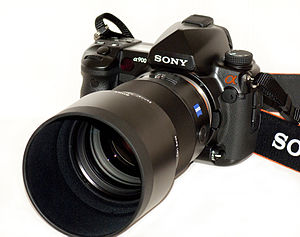Sony DSLR-A900
 |
|
| Overview | |
|---|---|
| Type | Single-lens reflex |
| Lens | |
| Lens | Sony mount; compatible with Minolta A-type bayonet mount. |
| Sensor/Medium | |
| Sensor | 35.9 mm × 24.0 mm Exmor CMOS sensor |
| Maximum resolution | 24.6 megapixels |
| ASA/ISO range | ISO 100–6400 |
| Storage |
Memory Stick: Memory Stick Duo, Memory Stick PRO Duo, Memory Stick PRO-HG Duo Compact Flash Type I, Type II (Microdrive), UDMA (Mode5) compliant |
| Exposure/Metering | |
| Exposure modes | Mode: Auto, Program Auto (P, with program shift), Aperture priority (A), Shutter priority (S), Manual (M) |
| Exposure metering |
TTL metering Cell: 40-segment honeycomb-pattern SPC Range: 0 EV to 20 EV (+2 EV to +20 EV with Spot metering) (at ISO 100 equivalent with F1.4 lens) |
| Shutter | |
| Shutter | Electronically controlled, vertical-traverse, focal-plane type |
| Shutter speed range | 1/8000 sec. – 30 sec., bulb |
| Viewfinder | |
| Viewfinder | Fixed eye-level system with optical glass type pentaprism, approximately 100%, 0.74x Magnification |
| General | |
| Rear LCD monitor | 3.0", 921,600 dots |
| Battery | NP-FM500H Lithium-Ion rechargeable battery (1650 mAh) |
| Optional battery packs | Vertical Grip VG-C90AM |
| Weight | 850 g (30 oz) |
| Made in | Japan |
Memory Stick: Memory Stick Duo, Memory Stick PRO Duo, Memory Stick PRO-HG Duo
TTL metering Cell: 40-segment honeycomb-pattern SPC Range: 0 EV to 20 EV (+2 EV to +20 EV with Spot metering)
The α900 (DSLR-A900) is a full-frame digital SLR camera, produced by Sony. An early design study of the camera was shown at PMA on 8 March 2007, and a newer prototype announced at PMA 2008 on 31 January 2008. Sony officially introduced the final camera on 9 September 2008 prior to photokina 2008. In October 2011, Sony Japan announced the camera's end of production.
The specifications include: 24.6-megapixel CMOS sensor, 5 frame/s burst mode, dual BIONZ processors, 100% viewfinder, 9-point AF with 10 assist points, inbuilt image sensor shift stabilization and intelligent preview. It does not have video/movie recording.
This mode, first introduced on the DSLR-A900, allows the photographer to take a sample image at the current settings. When this mode is enabled in the settings (default), then using the depth of field (DOF) preview button makes a preview image of the subject. The display shows the image and its image histogram, but it is not stored on the memory card. At that point, the photographer can accept current settings or simulate how the image (and histogram) would look with changes in aperture, shutter speed, dynamic range optimizer and white balance. If the photographer prefers those new settings he simply continues to work to accept them. Otherwise he can reject them by depressing the garbage can icon. He can also compare the sample to the simulation by depressing the DISP button.
The DSLR-A900 requires a labour-intensive alignment procedure in the factory in order to provide a 100% scene view in the viewfinder. In eliminating this costly procedure by masking the view to a slightly smaller area (98%) while also downspecifying the frame rate to 3 frames per second, the DSLR-A850 offers a camera with most of the benefits of the DSLR-A900 at a significant saving to the photographer.
...
Wikipedia
